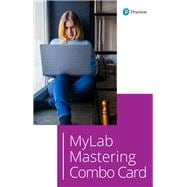This MyLab® Combo Access pack includes a MyLab Math access code plus a loose-leaf print version (delivered by mail) to complement your MyLab experience.
For freshman/sophomore, 2-semester or 2-3 quarter courses covering finite mathematics and applied calculus for students in business, economics, social sciences, or life sciences.
This ISBN is for the 24-month MyLab Combo Access pack. Pearson eText is included.
An applied presentation that makes the math meaningful
Finite Mathematics and Calculus with Applications,?11th Edition?prepares you for success in your future career with timely applications incorporated throughout. Known for using real data in their examples and exercises, the authors make mathematics relevant and accessible throughout the narrative, examples, exercise sets, and supplementary resources. You’ll have ample opportunity to relate what you’re learning to career situations through the Apply It question at the beginning of sections, the applied examples and exercises, and the Extended Application at the end of each chapter. The 11th Edition introduces coauthor Geoffrey Krader, whose enhancements to the MyLab® Math course make it an even more valuable learning resource.
Personalize learning with MyLab Math with Pearson eText
This flexible digital platform combines unrivaled content, online assessments, and customizable features so you can personalize learning and improve results.
Pearson eText is an easy-to-use digital textbook available within MyLab that lets you read, highlight, and take notes all in one place.
NOTE: Before purchasing, check with your instructor to confirm the correct ISBN. Several versions of the MyLab® and Mastering® platforms exist for each title, and registrations are not transferable. To register for and use MyLab or Mastering, you may also need a Course ID, which your instructor will provide.
Used books, rentals, and purchases made outside of Pearson
If purchasing or renting from companies other than Pearson, the access codes for the MyLab platform may not be included, may be incorrect, or may be previously redeemed. Check with the seller before completing your purchase.











